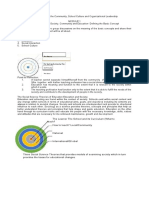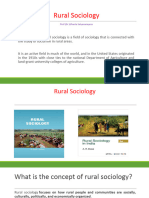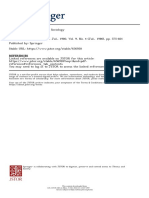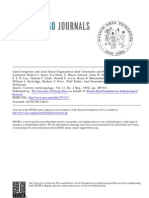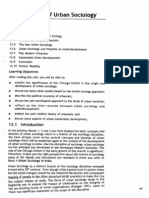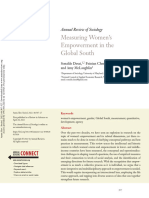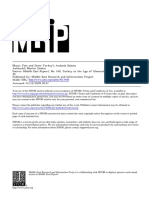See discussions, stats, and author profiles for this publication at: https://www.researchgate.net/publication/324739666
Rural Sociology
Chapter
· January 2018
DOI: 10.1016/B978-0-08-100596-5.22533-X
CITATIONS
0
READS
13,019
1 author:
Douglas H. ConstanceSam Houston State University
74
PUBLICATIONS
1,240
CITATIONS
SEE PROFILE
All content following this page was uploaded by Douglas H. Constance on 12 June 2019.
The user has requested enhancement of the downloaded file.

Provided for non-commercial research and educational use only. Not for reproduction, distribution or commercial use.
This article was originally published in
Encyclopedia of Agriculture and Food Systems
published by Elsevier, and the
copy attached is provided by Elsevier for the author’s benet and for the benet of the author’s institution, for non-
commercial research and educational use including without limitation use in instruction at your institution, sending it
to specic colleagues who you know, and providing a copy to your institution’s administrator.
All other uses, reproduction and distribution, including without limitation commercial reprints, selling or licensing
copies or access, or posting on open internet sites, your personal or institution’s website or repository, are prohibited.
For exceptions, permission may be sought for such use through Elsevier’s permissions site at:
http://www.elsevier.com/locate/permissionusematerialConstance D.H. Rural Sociology. In: Neal Van Alfen, editor-in-chief. Encyclopedia of Agriculture and Food Systems, Vol. 5, San Diego: Elsevier; 2014. pp. 62-74.© 2014 Elsevier Inc. All rights reserved.
Rural Sociology
DH Constance,
Sam Houston State University, Huntsville, TX, USA
r
2014 Elsevier Inc. All rights reserved.
Glossary
Adoption
–
diffusion of technology
Process by whichindividual farmers (or other prospective users of technology) make decisions about the use or nonuse of anew technology.
Land grant universities
Integrated system of teaching,research, and outreach created to modernize agriculture.
New Rural Sociology
Conceptual approach to thesociology of agriculture that embraced critical perspectivesof rural development.
Rural
–
urban continuum
Notion that the nature of socialstructure, social relationships, and values vary systematically across rural and urban communities.
Sociology of agricultural science
Study of the processthrough which scientists and scienti
c institutions discover new knowledge.
Sociology of agrifood studies
Study of the sociology of agriculture and food that links agricultural production andfood consumption to globalization and commodity systems.
Introduction
Rural sociology is historically de
ned as the sociological study of social organization and processes that are characteristic of rural societies and geographical areas where populationdensities are relatively low. In practice, modern rural sociology is considerably more comprehensive than the study of ruralsocieties. As rural societies do not exist in isolation, ruralsociology increasingly addresses the relationships betweenrural society and society as a whole and within the globaleconomy and society. Vertical linkages to the macrosystemintegrate rural areas into national and global social processes(Bonanno
, 1994; Warren, 1963).
Although rural sociology as a discipline originated in theUnited States in the early twentieth century, as part of deco-lonialization and modernization projects after World War II, it has diffused around the world where it is more often referredto as peasant studies, development studies, or village studiesinstead of rural sociology (Newby, 1980). Additionally, many of the foci of rural sociology are related closely to other socialscience disciplines including cultural geography, social an-thropology, and agricultural economics.
The Roots of American Rural Sociology
Although the
eld of rural sociology has made major strides inunderstanding rural social processes, like the parent disciplineof sociology, it still has strong roots in the nineteenth-century social thought. A central concern of nineteenth-century the-orists was whether village and farm life was morally and so-cially superior to metropolitan life, and whether rural life would be resilient in the face of urban industrialism. Informedby the Enlightenment and Western rationalism, the classicalsociologists Emile Durkheim (1858
–
1917) and Karl Marx (1818
–
83) both argued that urban
–
industrial capitalism andmodern technologies and organizational practices were un-avoidable and progressive social forces would eventually supplant the residual remnants of backward, preindustrialrural social forms. In contrast, Ferdinand Töennies(1855
–
1936) viewed urbanization and industrial capitalismthat characterized gesellschaft societies as leading to the de-cline of the pastoral virtues and intimate communal bonds of rural gemeinschaft societies that are necessary for healthy so-cial life. For Töennies and many early rural sociologists, thecities and social relations of industrial capitalism representedthe degradation of civilization. Although Max Weber (1864
–
1920) recognized the dynamism of the social forces of bur-eaucratization, industrialization, and urbanization that weremarginalizing traditional rural societies, he thought that bur-eaucratization and the industrial revolution, which he referredto as an iron cage, would lead to social movements, politicalideologies, and other forms of resistance to these forces of rationalization and uniformity. Throughout its history, rural sociology has engaged in thesenineteenth-century debates over the desirability and resilienceof traditional rural social organization. Two general positionshave alternated over time and still exist: (1) the view that ruralsociety, owing to its more intimate social bonds, lower inci-dence of social pathologies, and stronger religious institutions,is socially and morally superior to urban society and thereforedeserves to be preserved and (2) the view that traditional ruralbeliefs, social structures, technologies, practices, and insti-tutions are nostalgic anachronisms of the past and must bemodernized for the quality of rural life to be enhanced. Bothpositions are embedded deeply in Western social thought andcontinue to inform the discipline and discourses of ruralsociology. The historical roots of rural sociology in America reside inthe economic, political, and economic transformation brought about by the industrial revolution that occurred after the Civil War. Though the surge of industrial capitalism brought af
u-ence to many regions in the United States, it also createdpoverty and inequality in many rural areas. A benchmark publication in the debate between these two views of ruralsociety was Sorokin and Zimmerman
–
Urban Sociology, which synthesized rural sociologicalthought of the time and was the summative treatise in the
eld. Sorokin and Zimmerman
’
s
‘
rural
–
urban continuum
’
perspective drew primarily on Töennies
’
analysis of how
62
urbanization and industrial capitalism led to the undermining of the primary social bonds of community. Accordingly, therural sociology research carried out before World War II waslargely devoted to rural community studies and tended topresent rural life as socially richer and morally superior tourban life.
Agrarian Politics and the Country Life Commission
America
’
s agrarian politics also signi
cantly shaped the tra-jectory of rural sociology. Though the term
‘
rural sociology
’
was not widely used until the 1920s, the
rst American ruralsociological studies were conducted in the 1890s during adecade of populism and agrarian unrest. These pioneering rural sociological studies were initiated by DuBois (1898), ablack sociologist on the staff of the US Department of Labor.DuBois
’
studies emphasized how the postbellum crop-liensystem in southern plantation agriculture reinforced black poverty by tying black farmers to the plantation system andsubordinating them to the power of the planter class. During this time, studies of agricultural communities in the northeast were also undertaken by F.H. Giddings and associates at Columbia University. In these early days, land grant uni- versities had little or no presence in the scholarship now calledrural sociology. Although the populist critique of industrial capitalismswept through much of rural America during these years,populism did not directly in
uence early rural sociology.During the
rst full decade of American sociology, there was widespread suspicion among university administrators andtheir patrons that sociology should be scrutinized to ensurethat it concerned itself with empirical research rather thanpopulist politics. This political environment led most soci-ologists to distance themselves from radical social theories andmovements. There is no indication that any American ruralsociologists were active supporters of populism.Populism
’
s indirect in
uences on rural sociology, however, were important. The populists
’
mostly unsuccessful attemptsto recruit black farmers into their movement contributed tothe questioning of the sharecropping system, the structure of agriculture, and southern rural social structure. Populist rad-icalism was a major source of concern to urban industrialists who bene
ted from a socioeconomic system that provided astable supply of cheap food for their workers. Although Wil-liam Jennings Bryant
’
s loss in the 1898 presidential electionsignaled the defeat of populism in electoral politics, fear of aresurgence of populist radicalism remained for more than adecade. The aim of providing a moderate alternative to populism was integral to the establishment of the Country Life Movement (Danbom, 1979). Founded by industrial and other elites, theCountry Life Movement maintained that, contrary to populist assertions, rural social problems were not owing to the negativeimpacts of industrial capitalism, but rather because of a lack of organization, poor infrastructure, and technological backward-ness in rural areas. In 1908, President Theodore Roosevelt rec-ognized this reform movement by appointing a PresidentialCommission on County Life, chaired by Liberty Hyde Bailey,dean of Agriculture at Cornell University. The next six decadesof American rural sociology were framed by the Country LifeCommission Report published in 1909. The report did ac-knowledge many of the social problems of rural America (e.g.,the inequities of the crop-lien system and widespread share-cropping), but its dominant message was that an expandedeffort to modernize rural America technologically and socially was integral to improving rural society. The Country LifeCommission recommended the establishment of what is now called the Cooperative Extension Service to speed the modern-ization of rural America. The Cooperative Extension Service(Smith
–
Lever Act of 1914) completed the land grant collegemodernization triangle of teaching (Morrell Act of 1862) andresearch (Hatch Act of 1887). The Country Life Commission recommended the harness-ing of the social sciences, particularly agricultural economicsand rural sociology, to support the technological modern-ization of rural America. Rural sociological studies in landgrant colleges of agriculture were critical in helping to removesocial barriers to technological modernization and stabilizerural communities. The establishment of rural sociology,however, was slow and uneven, particularly compared withthe
eld of agricultural economics. Only a few land grant colleges
–
generally the larger ones in the Northeast andMidwest
–
established major rural sociology programs.Moreover, it was not until the Purnell Act of 1925 that federalfunds were available to support rural sociological research. For all practical purposes, the land grant colleges where ruralsociology was present in the 1930s are the same 25 or soinstitutions where rural sociology existed in the early 1990s.
Institutionalizing Rural Sociology
Three other historical factors were crucial in shaping and in-stitutionalizing rural sociology. First, the Great Depression andthe New Deal opened up vast opportunities for rural socio-logical scholarship aimed at rural reform and relief. By themid-1930s, sociologists in the United States Department of Agriculture (USDA) Bureau of Agricultural Economics (BAE)and other federal agencies had carried out an impressive pro-gram of empirical research on rural communities, ruralpopulation, and the structure of agriculture and had linkedthis research with an agenda for far-reaching rural reforms(e.g., reduction of the power of southern landlords, landtenure reform, and encouragement of cooperative forms of production). Second, the course of rural sociology was de-cisively shaped when in 1936
–
1937 rural sociologists brokefrom the American Sociological Society (later the AmericanSociological Association) to establish the Rural SociologicalSociety and started their own journal
Rural Sociology
. The or-ganizational break from the larger discipline of sociology ledrural sociology to become even more identi
ed with and in-stitutionalized within the land grant and USDA complex. Third, from the late-1930s through the mid-1940s the pro-gressive reformism of the New Deal came under attack by conservative members of the Congress. The crackdown on re-formist rural sociology (and agricultural economics) wascompleted when the BAE was disbanded in 1944. Seminal works on the relationship between the structure of agricultureand quality of life in rural areas carried out by Goldschmidt
Rural Sociology
63

